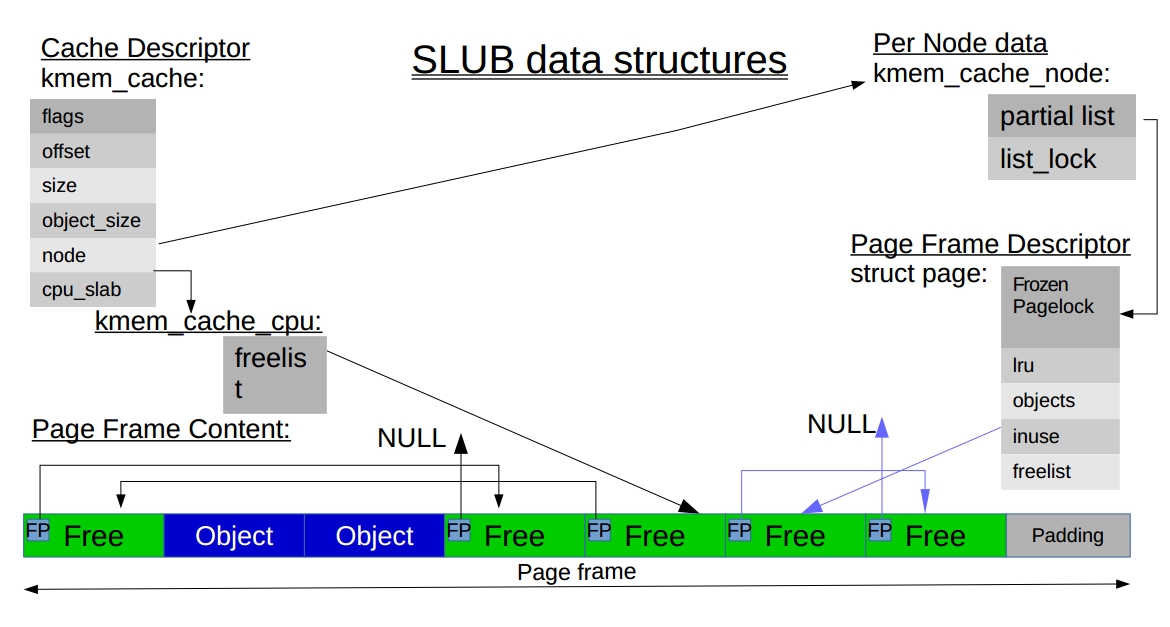SLUB 03:partial和cpu partial 2017-01-14
主要介绍partial和cpu partial的产生.
内核未定义 CONFIG_NUMA
partial没有指明是node partial还是cpu partial时, 则指的是node partial.
1. node partial的产生
在cpu0上执行newslabobjects -> new_slab, 由于可能睡眠, 之后可能运行在cpu1上. 这时若cpu1的c->page非空, 则根据情况, 可能将其放入node partial中.
linux-3.10.86/mm/slub.c
__slab_alloc
|--local_irq_save(flags);
|--freelist =new_slab_objects //buddy的page的首个obj
| |--page = new_slab(s, flags, node); //在cpu0上
| |--c = __this_cpu_ptr(s->cpu_slab) //进程可能迁移到cpu1上
| |--if (c->page) flush_slab(s, c);
flush_slab(struct kmem_cache *s, struct kmem_cache_cpu *c)
|-- deactivate_slab(s, c->page, c->freelist)
static void deactivate_slab(struct kmem_cache *s, struct page *page, void *freelist)
{
/*
while循环前:
obj_t2 -> obj_t1 -> NULL
^
@page->freelist
obj_03 -> obj_02 -> obj_01 -> NULL
^
@freelist
循环单次后:
obj_03 -> obj_t2 -> obj_t1 -> NULL
^
page->freelist
obj_02 -> obj_01 -> NULL
^
freelist
再来一回:
obj_02 -> obj_03 -> obj_t2 -> obj_t1 -> NULL
^
page->freelist
obj_01 -> NULL
^
freelist
问题:为何不直接修改指针把两个链表串起来, 而是要一个一个object的放到链表中?
答:因为要修改counters, 所以要一个一个数.
*/
while (freelist && (nextfree = get_freepointer(s, freelist))) {
...
}
....
/*
如果这里freelist为NULL, 说明@freelist传入时就为NULL
*/
/*把the last one也接上*/
if (freelist) {
new.inuse--;
/*
new->freelist
v
obj_01 -> obj_02 -> obj_03 -> obj_t2 -> obj_t1 -> NULL
^
freelist
*/
set_freepointer(s, freelist, old.freelist);
new.freelist = freelist;
} else
...
new.frozen = 0;
//有M_FREE, M_PARTIAL等情况, 这里只看M_PARTIAL
...
if (m == M_PARTIAL) {
/*问题:为何不是put_cpu_partial()?*/
add_partial(n, page, tail);
}
}
SLUB 04:tid 2017-01-14
1. tid
linux-3.10.86/include/linux/slub_def.h
struct kmem_cache_cpu {
...
unsigned long tid; /* Globally unique transaction id */
..
};
linux-3.10.86/mm/slub.c
#ifdef CONFIG_PREEMPT
/*
* Calculate the next globally unique transaction for disambiguiation
* during cmpxchg. The transactions start with the cpu number and are then
* incremented by CONFIG_NR_CPUS.
问题:一次不是加1, 而是加CONFIGNRCPUS, 为啥?
答:这个设计是为了让任何时刻每个cpu的tid值都不一样.
不过上面的注释有点老, 因为实际并不是加CONFIGNRCPUS, 而是TID_STEP.
SLUB 01:the SLUB allocator的相关数据结构和主要流程 2017-01-12
文来自本人旧博客: blog.163.com/awaken_ing/blog/static/1206131972016316114114855
平台 ARM Versatile Express for Cortex-A9 SMP
内核版本 3.10.86 (未定义 CONFIG_NUMA)
1. 概览
The SLUB allocator 相比SLAB, 试图 remove the metadata overhead inside slabs, reduce the number of caches, and so on. The only metadata present in the SLUB allocator is the in-object “next-free-object” pointer, which allows us to link free objects together. struct kmem_cache 的成员 int offset 用来指明 指针在 object 中的偏移量, 这个指针指向的是下一个可用的object. How does the allocator manage to find the first free object? The answer lies in the approach of saving a pointer to such an object inside each page struct associated with the slab page. SLUB allocator 没有SLAB的full list 和 empty list.

图片来自 http://events.linuxfoundation.org/sites/events/files/slides/slaballocators.pdf
linux-3.10.86/mm/slub.c
slab_alloc() -> slab_alloc_node()
slab_alloc_node(struct kmem_cache *s, ...
{
struct kmem_cache_cpu *c=__this_cpu_ptr(s->cpu_slab);
object = c->freelist;
if fastpath {
void *next_object = get_freepointer_safe(s, object);
c->freelist=next_object; //via this_cpu_cmpxchg_double()
}else
...
return object;
}
static inline void *get_freepointer(struct kmem_cache *s, void *object)
{
return *(void **)(object + s->offset);
}
调度器, 从lost wake-up problem说起 2017-01-11
文来自本人的旧博客 blog.163.com/awaken_ing/blog/static/1206131972016124113539444/
0. 引言
The lost wake-up problem 请参考 http://www.linuxjournal.com/article/8144
本篇主要解释为何修改后的代码没有问题.
修改后的代码为:
1 set_current_state(TASK_INTERRUPTIBLE);
2 spin_lock(&list_lock);
3 if(list_empty(&list_head)) {
4 spin_unlock(&list_lock); //如果这里面让出cpu?
//如果在这个点被生产者唤醒会如何?
5 schedule();
6 spin_lock(&list_lock);
7 }
8 set_current_state(TASK_RUNNING);
9
10 /* Rest of the code ... */
11 spin_unlock(&list_lock);
仅检查TIF_NEED_RESCHED,不检查preempt_count? 2017-01-11
1. 何时设置 TIFNEEDRESCHED
任务task01还没有完成, 但调度器认为 其运行的够久了, 就设置TIFNEEDRESCHED, 这样, 在合适的时机, task01就会被调度走, 由其他task使用cpu.
除了schedulertick会设置外, 当一个优先级高的进程进入可执行状态的时候, trytowakeup()也会设置这个标志。
2. 不检查preempt_count?
例 linux-3.10.86/arch/arm/kernel/entry-armv.S
__vector_irq()
|--__irq_usr() @entry-armv.S
| |--usr_entry()
| |--irq_handler()
| |--ret_to_user_from_irq() @entry-common.S
| | |--work_pending()
| | | |--do_work_pending @signal.c
do_work_pending
{
do {
if (likely(thread_flags & _TIF_NEED_RESCHED))
schedule();
else
...
}
}